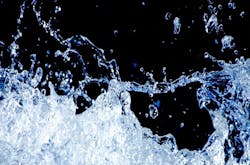Filter Backwash
Analytical Technology, Inc.www.analyticaltechnology.com, 800.959.0299
The Punta Gorda, Fla., Water Treatment Plant is a 10-million gal per day (mgd) surface drinking water facility. The process includes flocculation tanks and four solids contact units (SCUs), which are a form of upflow clarifier. The tanks feed two greenleaf filters with four cells each. The filters are backwashed every 70 hours regardless of head loss. The high backwash flow rate is 5,200 gal per minute (gpm). The total cost to treat 1,000 gal of drinking water is $1.73.
During the field trial, it was noted that the loading in the filters was light (See Figure 1). This can be seen in the low turbidity measured during the backwash. Since the backwash schedule was based on time and not head loss, it was suggested that the plant incrementally increase filter run times (FRTs) until the head loss value was reached. FRTs were increased to roughly 150 hours at one point but were backed off to 120 hours due to various concerns. This initial process adjustment resulted in a 42% decrease in backwash water consumption at a value of approximately $65,000 annually.
Once the instruments were purchased and installed, backwash data indicated that the high-rate portion of the backwash was longer than necessary, and it was reduced by four minutes (See Figure 2). This adjustment saved approximately 22,100 gal of wash water per wash at a value of $21,000 annually. Together, the two adjustments to the backwash process saved $86,000 in the first year. These savings are more than twice the total price of the instruments.
The water in the SCUs flow up through a blanket of sludge and into collection pipes that send the water to the filters. The sludge blanket rises, then it cascades into a trough, from which it is pumped to the drying process. An EchoSmart sludge blanket monitor was installed in each of the four sludge troughs, and the signals were used to control the sludge pumps. This kept the sludge level in the troughs within a 6- to 8-in. range. Previously, the pumps were turned on and off manually, which produced inconsistent results. Using the EchoSmart blanket level to control the pumps eliminated inconsistencies and reduced the hydraulic loading to the sludge-drying train.
The most unexpected and significant savings came from the sludge-drying process. Backwash water and the sludge from the SCUs first go to a decant tank, where the sludge settles and the supernatant is returned to the headworks. The settled sludge goes to one of a 12 three-walled drying cells with underdrains. A layer of sand is spread in the cells to protect the underdrain from the action of the front-end loader. Previously, all 12 cells were needed; with the reduced hydraulic loading, only one or two cells are needed. Consequently, the amount of sand has been reduced.
“We used to order between $200,000 and $300,000 of sand a year,” said Brian Fuller, plant supervisor. “Since we implemented the blanket monitors, we haven’t ordered sand in a couple of years.”
The savings to the plant in the first couple of years after installing the monitors could easily be more than $500,000.
“We love these instruments,” said Tom Jackson, utilities director. “They’ve given us data that we can use to make decisions that have saved us a lot of money.”
